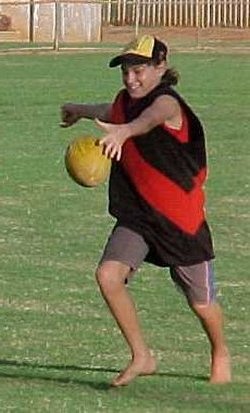 13. FOOTBALL SCORES
13. FOOTBALL SCORES 
Watching Australian Rules football on television the other day, we noticed Collingwood’s dismal score:
Goals Behinds Points 4 8 32
Nick turned to me and commented: ‘4 x 8 = 32. I wonder if any other scores behave like that?’
Switching channels, we found that the Cats had managed
Goals Behinds Points 9 5 59
‘That pattern is nearly as good,’ said Lindy. ‘A genuine palindrome – 9559. I wonder whether that happens with any other score?’
Finally we noticed that Port Power‘s score (part way through the game!) was
Goals Behinds Points 2 4 16
‘Beat that!’ said Karen. ‘24 = 16. Surely that one is unique!’
Noting that a goal is worth 6 points, and a behind is worth 1 point, what say you?
Hint 1
Let g stand for the number of goals, and b for the number of behinds. In each of the three problems, obtain a relationship between g and b which must be satisfied. Now find the numerical solutions.
Solution
Let g stand for the number of goals scored, and b the number of behinds. The number of points is then 6g + b. All the solutions are listed in the table below.
|
Goals
|
Behinds
|
Points
|
N
|
7
4
3
2
0
|
7
8
9
12
0
|
49
32
27
24
0
|
L
|
9
0
|
5
0
|
59
00
|
K
|
2
|
4
|
16
|
For Nick’s problem we require g x b = 6g + b, or g = b/(b – 6). We test values of b up to 12 (since g is an integer), to find those which give integer values of g.
In Lindy’s problem, the number of points is
6g + b = 10b + g, that is, 9b = 5g.
Only single digit numbers will provide solutions to this problem.
For Karen’s problem we require gb = 6g + b.
This has no positive solutions with b = 1 or g = 1. Now checking cases with b = 2, 3, 4 will quickly convince you that Karen’s solution is the only one.
Extensions
1. The principle demonstrated here will apply to any game where there are two or more units for scoring. You might look at rugby, Gaelic football or cricket (1s, 4s and 6s).
2. Where the date is written as day/month/year we can get similar patterns; for example the palindrome 6/9/96, or the product 10/8/80. Devise some problems for the current year.
Hint 1
Solution
Extensions

